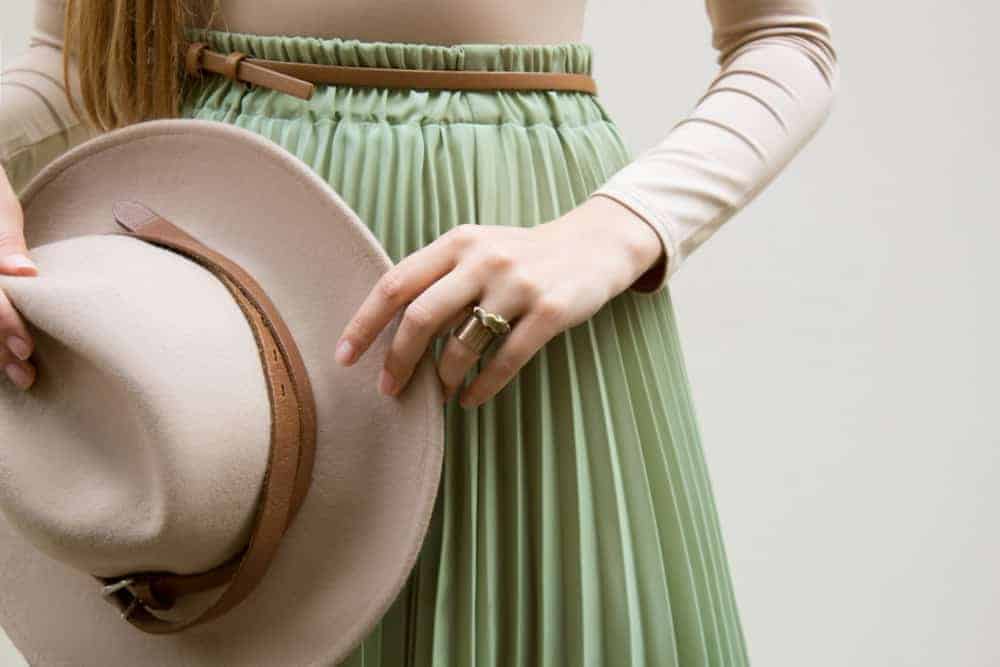Whoa! Did you think there are 65 different types of skirts? Yup, there are that many which is nuts. We put together an awesome skirt chart showing all 65 with custom illustration.
In today’s fashion, skirts are frequently associated with women. But in the history of fashion, they’ve mostly been worn by men. Get to know more about all the different types of skirts. How many of them have you worn?
Contents
- Skirt History
- Types of Skirts
- A Line
- Asymmetrical
- Balloon
- Bell
- Box Pleat
- Broomstick
- Bubble
- Bustle
- Button Up
- Cargo
- Circle
- Cowl
- Dirndl
- Draped
- Flared
- Full / Gathered
- Godet Pleat
- Gored
- Gypsy
- Handkerchief
- High Low
- High Waist
- Hobble
- Inverted Pleat
- Layered
- Lehenga
- Maxi
- Mermaid
- Midi
- Mini
- Paneled
- Peasant
- Pegged
- Pencil
- Peplum
- Pleated
- Poodle
- Prairie
- Rah-Rah
- Ruffle
- Sarong
- Scooter
- Slip
- Tea Length
- Tiered
- Tulip
- Tulle
- Tutu
- Underskirt
- Wrap
- Yoke
- Men’s Skirts
- Materials
- FAQs
- How many types of skirts are there?
- Which types of skirts are in fashion right now?
- Which types of skirts are easy to sew?
- Which types of skirts work for your body type?
- Which skirts look good in plus sizes?
- How many skirts should a woman own?
- Can skirts be taken in or let out?
- Why do field hockey uniforms have skirts?
- Which types of skirts can you wear with sneakers?
- Can you wear skirts with sweaters?
- Which types of shoes can you wear with skirts?
- What types of skirts do royals wear?
- Is a kilt a skirt?
Skirt History
Skirts are actually older than pants in the history of fashion, according to Bustle. Think about depictions of ancient civilizations. The Roman soldiers wore skirts. The Greeks wore long togas, which were really dresses. Aztecs wore loincloths, a type of skirt. Even the Egyptians, both men and women, wore short skirts. Pants weren’t even fashionable for most of human history. Roman soldiers were surprised to learn that people in Britain wrapped their legs in cloth when they first invaded.
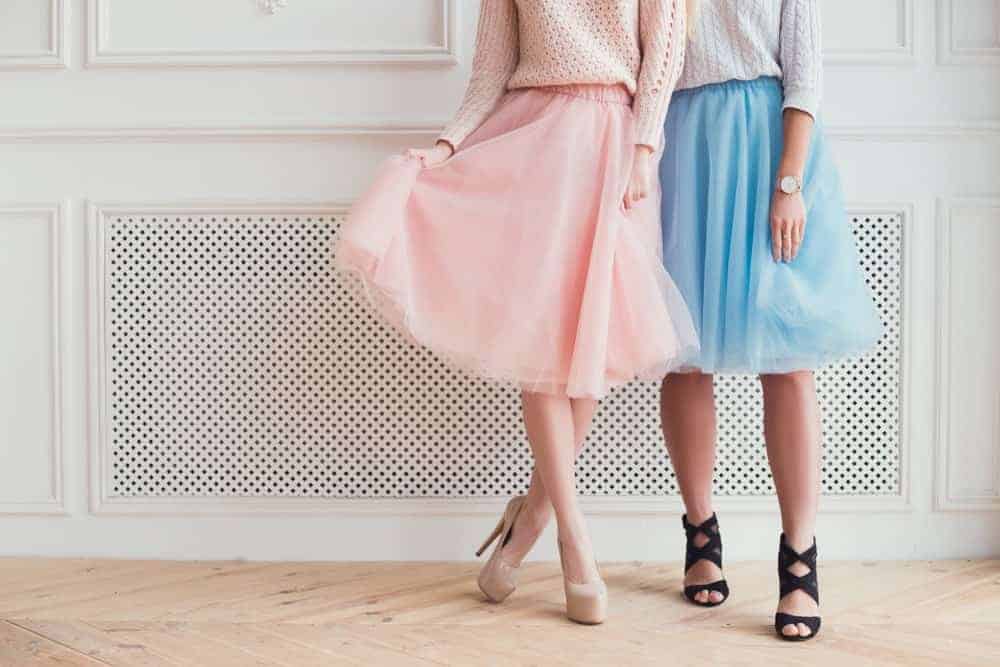
So skirts were one of the first pieces of fashion ever created, which makes sense. After all, it’s much easier to wrap something around your waist than to shape and cut leather so it can be wrapped around your legs.
Men in Pants
Pants didn’t become the most popular fashion choice for men in Europe until the 1300s. That’s when pants became much easier to make and must nicer-looking thanks to advances in the art of tailoring. Even then, for hundreds of years, men and women both wore skirts and pants. It wasn’t until the 1800s that skirts became something considered to be strictly women’s wear.
Women in Skirts
Skirts took on a certain symbolism for women over the centuries. Long, multi-layered skirts became a sign of prestige. After all, fabric is expensive. Later, women used skirt lengths to display their own empowerment as a way to claim their own identities. Skirts can have meaning and they can have power and they’re one of the oldest pieces of clothing ever created. Maybe that’s why today, there are so many types of skirts to choose from!
Types of Skirts
Skirts have changed and evolved many times throughout history as styles have come and gone. Some types of skirts are practically timeless, while others were worn only for a brief time. How many of the different types of skirts will you recognize?
A Line

When it comes to selecting a skirt for versatility, the A line skirt is the way to go. A line skirts are designed to flatter a figure by being fitted at the waist and hips but flaring out the closer it gets to the hem of the skirt. This design allows for free flow and movement and looks good as a professional style for the office or for a casual style when out on the town. The A line skirt got its name because the silhouette looks like the letter A.
History
The A-line first appeared in the 1950s. It was introduced by Christian Dior and became popular with women who liked the simple, elegant lines of the skirt. When Jackie Kennedy was photographed wearing an A line skirt, millions of women bought their own.
Asymmetrical

Asymmetrical skirt styles look very modern and cool, and they’re everywhere right now. All the hot celebs are showing off their style with asymmetrical hemlines, a radical break from the traditional styles of the past.
…Right? Actually, asymmetrical skirt styles are nothing new. In fact, they’ve been around for 150 years.
History
Who says the ladies of the Victorian Era weren’t radical? The asymmetrical fishtail style of skirt was hot in the 1870s…and again in the 1880s, 1920s and 1930s.
Style
The asymmetrical skirt is definitely one of the most popular skirt looks, even though it’s actually just as historic as the hoop skirt! So the next time you wear an asymmetrical skirt, just remember that you are paying homage to fashion history.
Balloon
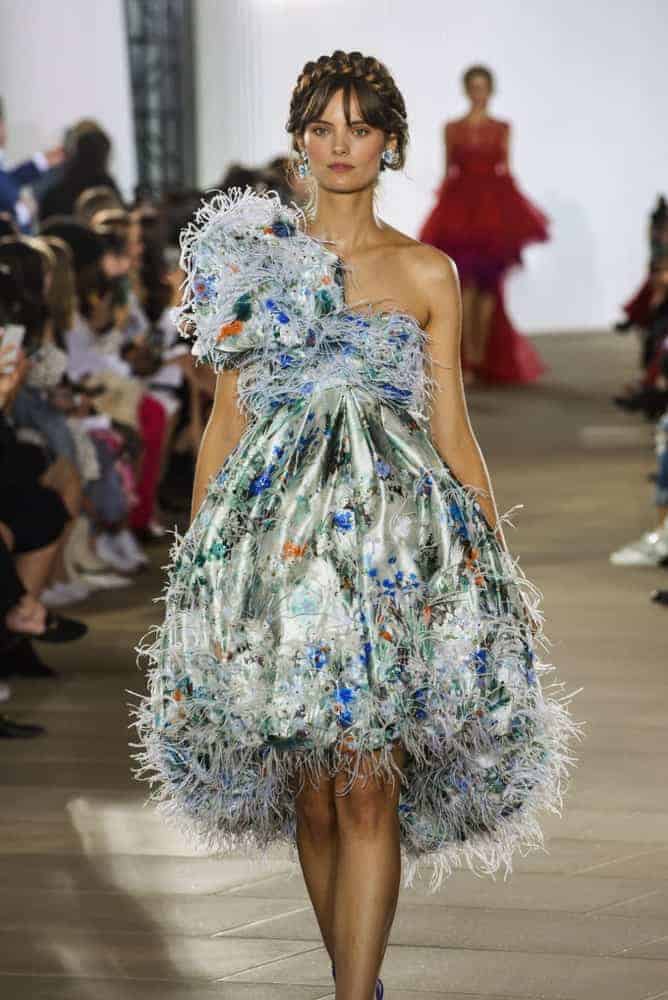
Some types of skirts are easy to confuse with others. This is not the case with the balloon skirt. This is a distinct silhouette that you aren’t going to confuse with anything else. The balloon skirt is fitting at the waist. It’s a full skirt that is folded upward and gathered at the hem to make the skirt even fuller. This creates the poofy look that gives this skirt its name.
Style
Balloon skirts can be in any length or style. They may be pleated or asymmetrical. Balloon skirts often combine several different skirt styles in a single, eye-catching design.
Bell

The bell skirt, also known as the crinoline, has become the signature look of mid-1800s fashion. This enormous skirt is practically Scarlett O’Hara’s co-star in “Gone With the Wind” and it’s so impractical, it is literally a potentially fatal fire hazard. While many fashion trends tend to come and go, it isn’t likely that the enormous bell skirt will ever become popular again.
History
Women were wearing big, full skirts for a long time before the bell skirt style caught on in the 1840s. But for whatever reason, it was this decade that caused skirts to get bigger and bigger and bigger…until they became the gigantic bell skirts that look completely ridiculous today. Women had to wear several layers of petticoats to get the huge bell look, which sometimes weighed as much as 14 pounds.
It all changed in 1856. This is when the “cage” crinoline was invented. Basically, it was a petticoat made of steel wire. This could give women the huge volume that was popular for skirts but without all that petticoat weight. This is the device you see women wearing in all the movies set during the Civil War and this is the distinct look of the mid-1800s. This is why the bell skirt is also called the hoop skirt.
Fatal Fashion
The bell skirt may be the most dangerous skirt on the list. These skirts were made with highly flammable fabrics…in an era before electricity was used. Everything was lit by candles and there were open flames everywhere. In the short two decades when the bell skirt was popular, around 3,000 women died in crinoline-related fires in the country of England alone. That’s one deadly skirt.
Style
No one wears bell skirts anymore, which were too big for practical wear. Skirts became so huge that women had trouble getting through doorways and any social event ended up cramped even with just a few guests. The huge bell skirt made even sitting difficult, and crawling in and out of a carriage was certainly a struggle. Toward the late 1800s, fashion slimmed way down and skirts became much more manageable. The bell skirt ended up as a brief fashion moment that is unlikely to ever make a return. Whew!
Skirts that have the bell-shaped design are usually flared on both ends. This flare on both sides of the skirt allows the skirt to look more elegant and also to look as if it has been layered. Bell skirts can come in various lengths and colors. The design of a bell skirt also makes the skirt look formal whether it is made with a solid color, print, or plaid.
Box Pleat
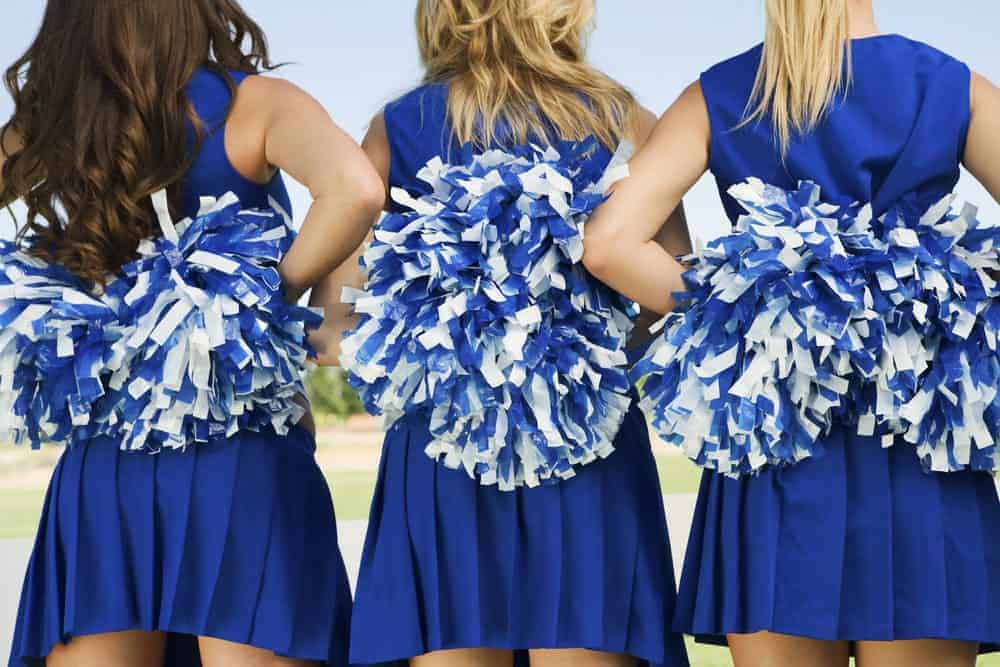
You may think of the box pleat skirt as a cheerleader skirt since box pleats are very commonly used to make this garment. Box pleats are a popular type of pleat that creates a distinct style. Once you know how to recognize a box pleat, you’ll always be able to spot this style feature.
Style
The box pleat is two pleats that are folded toward each other. This is a deviation from standard pleated skirts, which are made with pleats that all go in the same direction. Box pleats skirts can be made with only a few box pleats to add a little definition, but they can also be used all the way around a skirt to create a fun, flared look like you see in cheerleader skirts.
Broomstick

The broomstick skirt has a very familiar, classic fashion look. You’ve seen broomstick skirts and maybe you’ve even worn one before, but you probably didn’t know the name of this distinct, casual skirt.
Design
The broomstick skirt is a long, full skirt that has many small pleats all the way around. What’s most distinctive about the design is the wrinkled appearance of the pleats. They are not long, straight pleats. Rather, they have a crinkled look to them. This effect is actually achieved in a very specific way. And yes, it involves a broomstick!
The little creases in this skirt are achieved through wetting the material thoroughly and then wrapping it around a broomstick, where it is left to dry. Once the skirt is unwrapped from the broomstick, it has the unique look that the broomstick skirt is known for.
Style
Broomstick skirts are usually designed for comfort. They can come in various lengths but the most common length is usually long down to the ankles. They almost always have an elastic waistband which allows for even more comfort and flexibility. This type of skirt has its pleats throughout the entire length of the skirt to help increase its mobility.
It does not give off a formal or elegant look but instead, it says comfort, casual and cozy. A broomstick skirt is a perfect skirt to wear lounging around, out to the park or for an evening at the movies.
Bubble
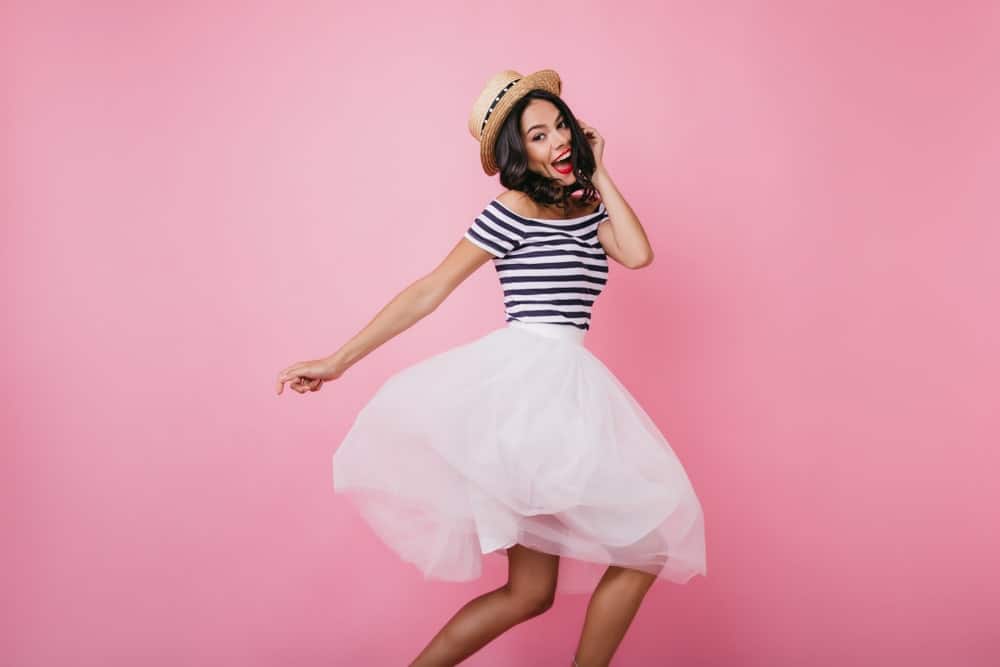
What would 1980s fashion be without the bubble skirt? Yes, it looks uncomfortable. Yes, it is sort of strange the first time you see it. And yes, it’s an absolutely great piece of fashion history.
History
The bubble dress is pretty iconic, a silhouette that’s recognizable right away. The bubble shirt is a full, wide skirt that is gathered near the bottom, which bunches up the upper portion of the skirt to create a distinct shape. And while this skirt has a totally awesome ’80s look to it, this shape originated in the years after WWII, according to CR Fashion Book.
That’s right: this is a 1950s skirt. It became a hot look during this decade and many designers created cocktail dresses with bubble skirts. Many A-list glamor girls wore evening gowns made with bubble skirts.
Style
Bubble skirts appeared on the fashion scene again in the 1980s and recently, they’ve come back yet again. More bubble skirt styles have appeared on runways recently, proving that this is a look that won’t ever completely go away.
Variation
Bubble skirts are also called puffball skirts because of their shape. They’re also called harem skirts.
Bustle
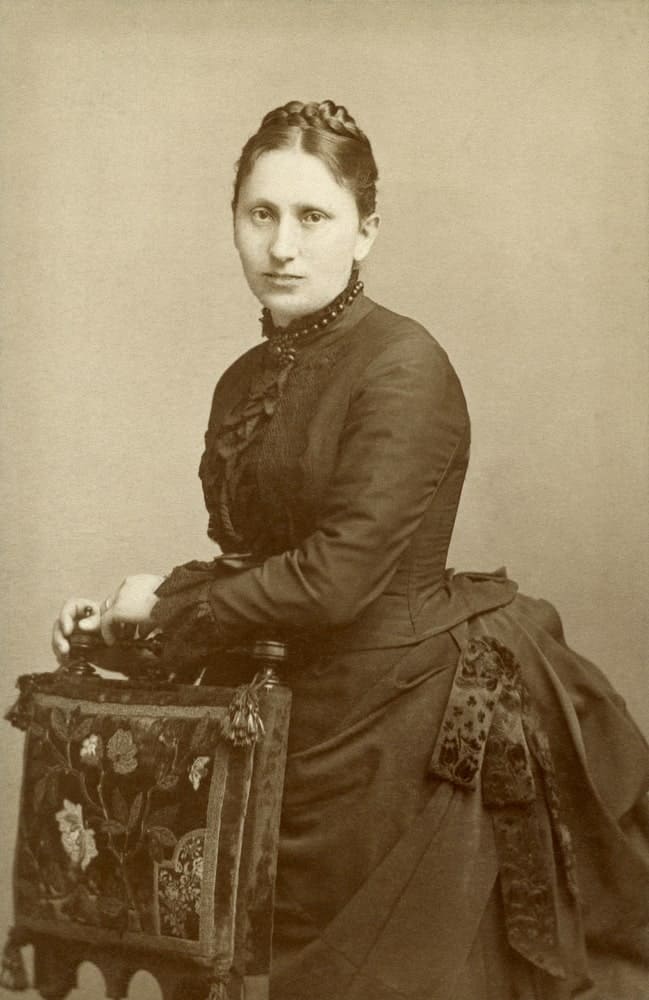
The bustle skirt, or bustled skirt, may be the most uncomfortable skirt on the whole list. After the enormous and impractical bell skirt stopped being trendy, fashion presented women with another horrible idea: the bustle skirt.
Style
Anyone can see a bustle skirt in an instant. This is a skirt that was gathered in the back, just below the small of the back. The sides of the skirt were also drawn back so that all the material of the skirt was gathered right over a woman’s rear end. It created quite a distinct shape that’s always on display in movies set during the late 1800s.
In some designs, the bustle in the back of the dress was truly enormous, emphasizing this strange skirt silhouette.
Women couldn’t sit in a standard sitting position while wearing bustled skirts, for obvious reasons, according to Smithsonian Magazine. And as silly as this style sounds, it’s actually still around. Bustle skirts are still quite frequently used in wedding gowns.
Button Up
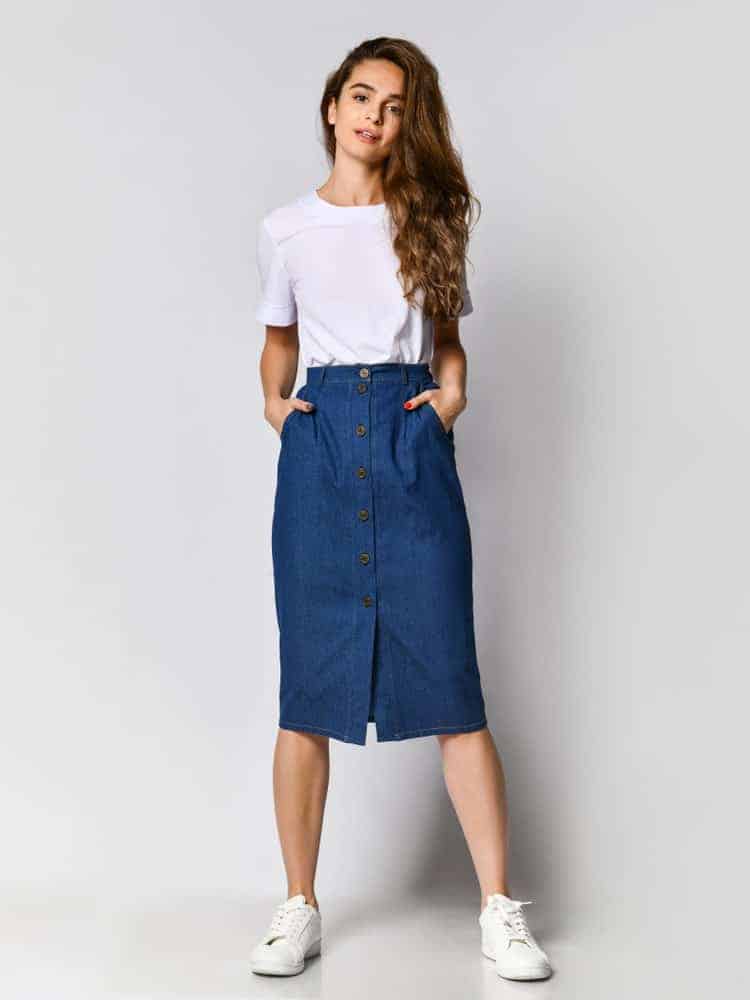
Button up skirts are usually skirts that have buttons all the way down the front or the side of the skirt. Most of the time, button-up skirts are worn in casual settings. The skirts can be made out of various materials. However, they are more commonly seen made out of denim.
Style
A button-up skirt, button-down skirt, button skirt or button front skirt can really be any type of skirt. Mini skirts, maxi skirts and any other type of skirt can be made with a button front. This adds a little bit of extra style and character to a skirt, but it’s also considered to be more of a casual look. The buttons can be functional or merely decorative.
Cargo
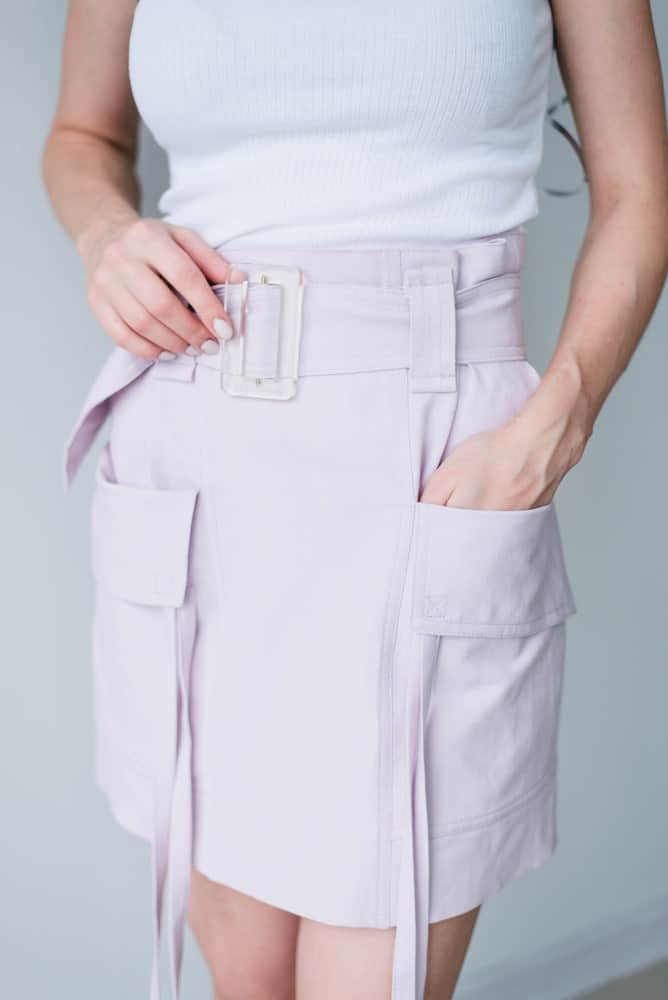
Cargo skirts have cargo pockets, just like the cargo pants that inspired this look. The large patch pockets immediately set cargo skirt styles apart from other types of skirts. Cargo skirts are usually casual skirts and they’re usually tough, made with durable, easy-to-wash fabrics.
Style
Cargo skirts can be any length and any style. The important feature is the patch pockets.
Circle
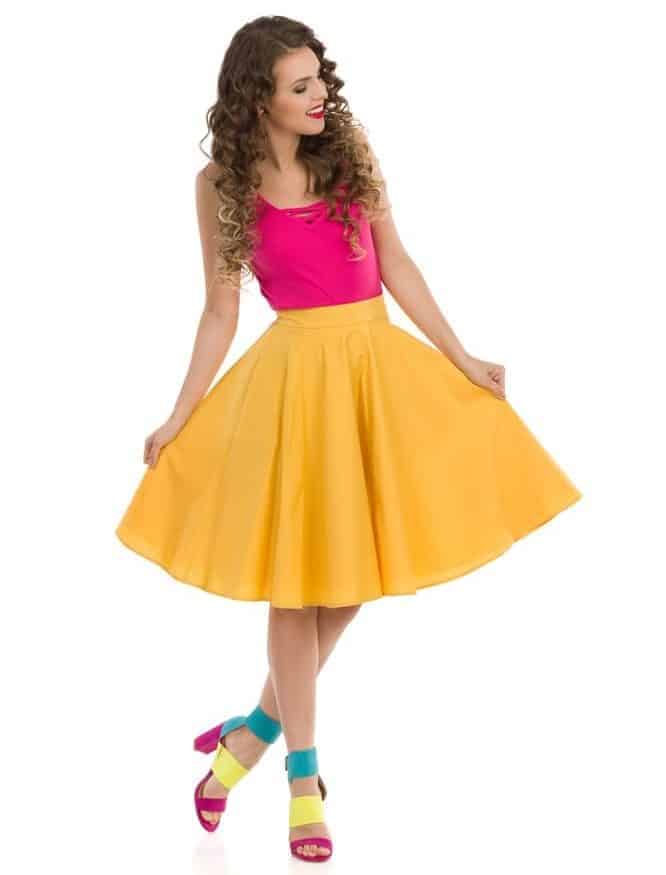
The pattern for the circle skirt dates to at least the early 1900s but this skirt didn’t really come to fashion fame until the 1950s. And when you consider how simple the circle skirt is, it’s likely that this skirt style has actually been around for a long, long time.
Style
The circle skirt, also known as the circular skirt and the swing skirt, is one of the simplest skirt styles on the list and one of the easiest to make if you get into a DIY mood. The circle skirt is made from a single piece of fabric that is, quite literally, cut into a large circle. A smaller circle is cut out right in the very center. This is for the waist. Add a few buttons or a zipper to the waist and the skirt is ready to wear.
In the classic 1950s style, the circular skirt falls to about mid-calf and can be worn with a slip to add volume to the skirt. Because of the way it’s made, the circle skirt is a full, flared skirt. It’s a highly versatile style that can be worn for casual wear or formal wear, depending on the fabric and the design.
Variation
When the circle skirt is made in a short, above-the-knee style, it’s called a skating skirt. The skater skirt, sometimes called the skating skirt, was inspired by ice skating costumes of the 1980s. This is a short, flared skirt with a high waist. This 1980s skirt trend is still seen everywhere today. Chances are, you’ve got a skater skirt in your closet right now.
Cowl
The cowl skirt design is gathered at the hips, which creates a cowl design that is similar to the cowl neckline. Beneath the gathered section above each hip, the rest of the cowl skirt tapers to fit closely around the legs.
Dirndl

A dirndl skirt (pronounced durn-dull) is a simple skirt that was super popular in the 1950s. This is a full, long skirt that is typically knee-length or longer. It’s a style that’s still worn today but what most people don’t know is that the dirndl is actually a traditional Austrian skirt.
History
The simple dirndl skirt is traditional folk wear in the Alps region that was widely seen in the 1800s. It’s seen in “The Sound of Music.” Traditionally, the dirndl also has a short apron and shoulder straps but in modern styles, the skirt is typically made without these features.
The traditional dirndl skirt is also tied with a knot at the waistband. The position of the knot actually conveys a meaning. A girl who is single would wear the knot on the front and to the left of her body. Married women wore the knot on the right side of the waistband. Widows tied the knot at the back of the waistband.
Draped
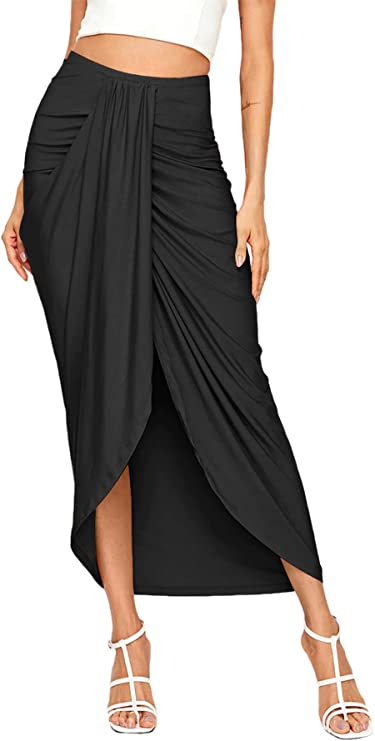
Draped skirt styles, as the name suggests, are made to be draped around the body. This may be done in a symmetrical or asymmetrical style and the skirt may be of any length. The draped skirt is one of the oldest skirt styles, dating to ancient Greece and other ancient cultures. Many modern designers have played with the draped look. The cowl skirt is a version of the draped skirt.
Flared
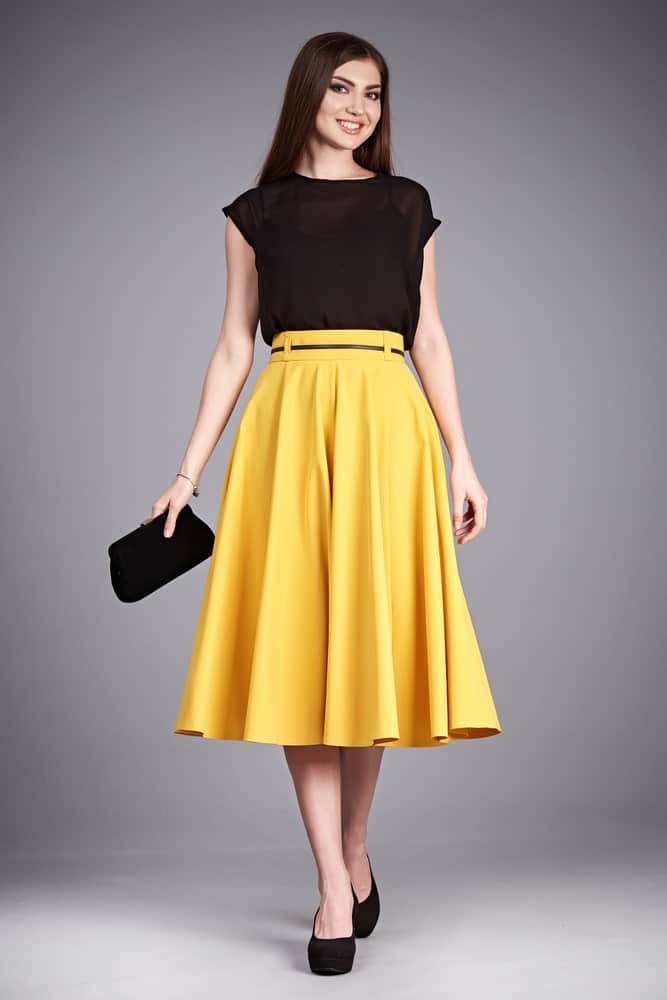
There are several types of skirts that can be categorized as flared skirts. A flared skirt has a lot of volume and flares out from the body. This is in contrast to skirts like the pencil skirt, which is very form-fitting and hugs the legs. Any skirt that flares out from the hips is a type of flared skirt. A flare skirt style can be short or long.
Full / Gathered

A full or gathered skirt is seen in several different types of skirts. The bell skirt is also a type of gathered skirt, as is the dirndl skirt and the prairie skirt. A full or gathered skirt is made with a lot of fabric in a design that is gathered at the waist, often with an elastic or drawstring waistband.
Godet Pleat

The godet pleat skirt, or godet skirt, is often used in cheerleader skirts. This style is great for those who like a lot of color in their outfits. The godet pleat is made with extra triangular pieces of fabric that are inserted into the pleats at the bottom of the skirt. The extra fabric is in a contrasting or complementing color to the main body of the skirt. This creates a two-color flared skirt design.
Godet pleat skirts can be made in any length but this design is most commonly used in shorter, above-the-knee skirt styles.
Gored
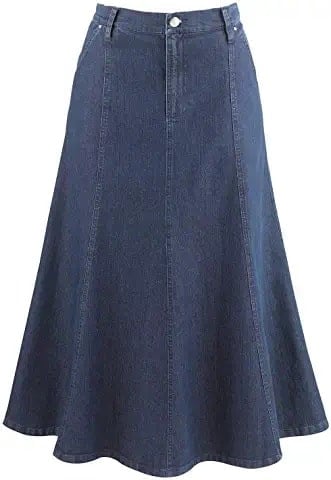
The gored skirt is made with a unique design that sets it apart from every other skirt on this list. In a gored skirt design, triangular pieces of fabric are stitched together. The points of the triangles form the waist, with the triangles getting wider through the skirt so that the bases of the triangle form the bottom of the skirt.
Style
The construction of the gored skirt is similar to the way the godet pleated skirt is made because the latter also uses triangular pieces of fabric. However, in the gored skirt design the triangles run the full length of the skirt. In the godet skirt, the triangles are inserted near the bottom of the skirt.
Gored skirts can be made in any length and usually, they are made from a singular shade of the same fabric throughout.
Gypsy

The gypsy skirt is a fun, colorful type of skirt that is easy to make as a DIY project. The homemade look is what gives this skirt a lot of its charm. The gypsy skirt is a long, full skirt that’s made with a lot of fabric in a wide, flared style.
Style
The most distinct feature of the gypsy skirt is the tiered design. It’s made up of bands of fabric that are sewn together, with each band being larger in circumference than the one above it. This is what creates the flared design.
The different tiers of the skirt can be made with the same fabric or with different colors of fabric to create all sorts of different looks. Gypsy skirts may have a range of colors, from black to pink.
Handkerchief
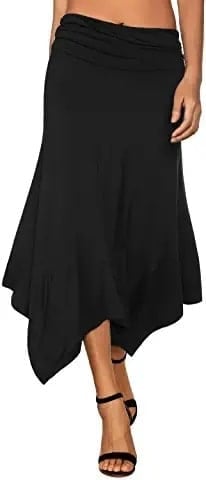
The handkerchief skirt doesn’t have to be made out of handkerchiefs but it can be. This is a layered skirt that is made with multiple pieces of square fabric that are stitched together with the points facing downward to give the skirt a zigzagging hem. Usually, this skirt is at least knee-length and may be longer.
This is a flaring skirt that can be casual or formal, depending on how it’s styled. Handkerchief skirts can be paired with lots of different tops.
High Low

The high low skirt is also called the mullet skirt because it’s short in the front and long in the back, just like the haircut. Unlike the haircut, this skirt is actually in style. According to Vogue, this look appeared as early as the 1920s…and may not have been well-received at the time.
History
A story published in 1945 recounts the author’s experience with a high low dress in 1920. According to her anecdote, the skirt was strange-looking and the subject of a joke. But this style is no joking matter now. Many celebs have been spotted wearing this skirt style, which was perhaps a little ahead of its time back in 1920.
High Waist
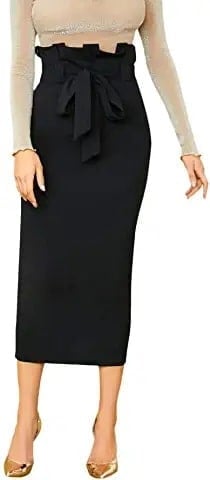
The high waist skirt, which may be called an empire waist, sits higher than the natural waist, rising up to just under the bustline. The empire waist was very popular in the early 1800s and was seen again a century later. It made another appearance in the 1970s.
It’s been seen on the catwalks more recently. When styled well, high waist skirt designs look pretty amazing. Try pairing one with a brief crop top, tube top or halter.
Hobble
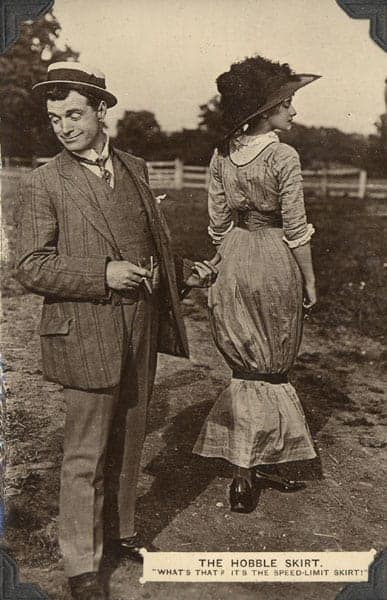
Several skirts in fashion history have been not just extremely impractical but also super difficult to wear. The hobble skirt may be the most difficult skirt to wear on the list. This skirt became popular for a very brief moment in time at the beginning of the 1900s. Because of the way it was designed, the hobble skirt was extremely hard to walk in…which is definitely not something you want in a skirt.
Style
The hobble skirt is a full-length skirt that is full around the hips and thighs. But then, inexplicably, the bottom of the skirt is quite tight around the ankles. These skirts were so tight, in fact, that women could only walk in them by taking very tiny, shuffling steps. And yes, for some reason, women actually wore this. It was popular. Sometimes, fashion is a little strange.
To make matters worse, women wore a hobble garter to go with the skirt. This was a fabric band that wrapped around each leg, right below the knee, to hold the legs together. This prevented women from taking too-large steps that may rip their hobble skirts.
Needless to say, this fashion trend didn’t last very long. Coming out of the 1910s and the restrictive fashions that had come before, women turned toward much shorter skirts in the 1920s and fashion changed significantly.
History
Middle Eastern and Asian culture became very fashionable in the early 1900s. People in the Western world were suddenly fascinated by these places, which seemed quite exotic and mysterious in those days. The French fashion designer Paul Poiret drew inspiration from this region, and public taste at the time, using Eastern cultures to influence his fashions. The hobble skirt was his take on the billowy harem pant style that was popular in the east.
Inverted Pleat
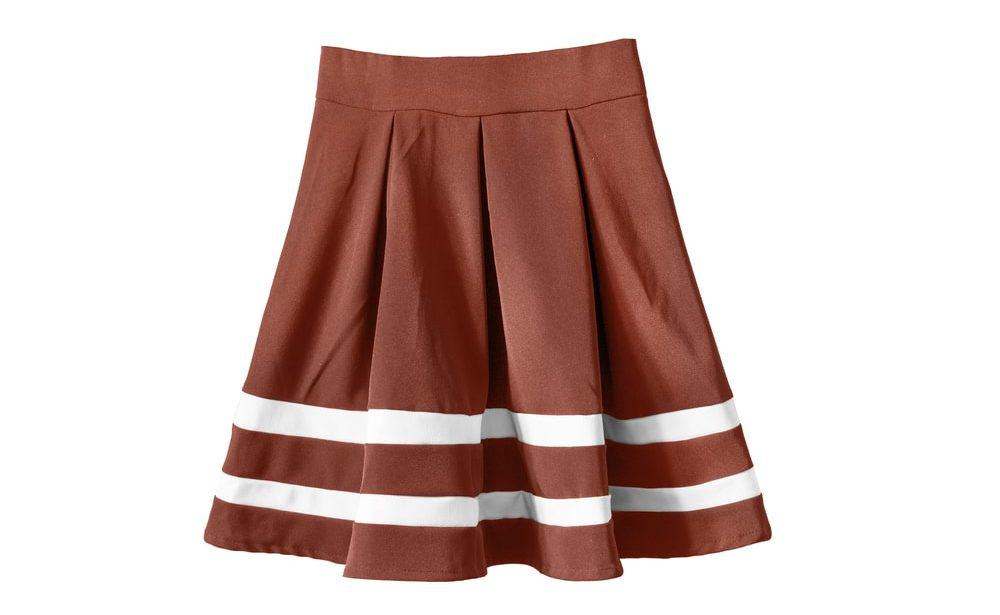
Inverted pleat skirts, also called inverted pleated skirts, are just like any pleated skirt but with one major difference. With ordinary pleats, the pleats are folded so that the folded edges are facing outward. With inverted pleats, the folds of the pleats face inward. This creates a look that is different from standard pleats. Any type of pleat, including box pleats, can be inverted.
Layered
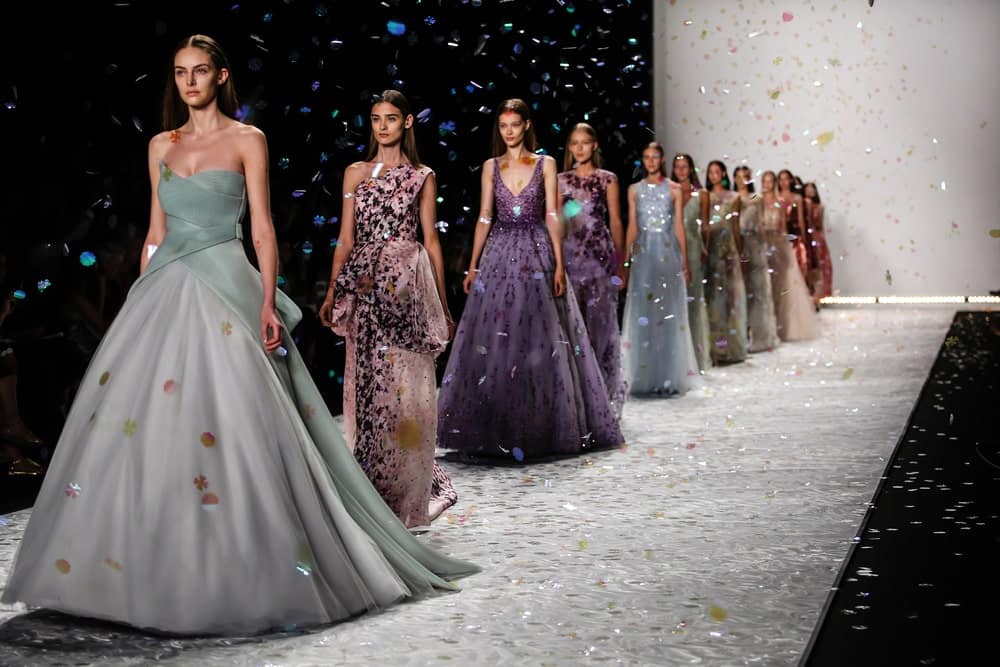
Layered skirts are any type of skirt that has multiple sections throughout the entire skirt. This type of skirt usually has layers made out of the same materials, patterns and colors. They can come in either long or short styles. Layered skirts are simple with their design and were created for comfort. Sometimes these skirts can be found with their layers made out of a different pattern, materials or colors.
Lehenga

The lehenga skirt is a traditional skirt that is worn in India. This is a long skirt that is highly decorated. Lehenga skirts are made in four basic styles: a straight skirt that goes down from the hips with no flare or tapering; a flared skirt; a pleated skirt; a mermaid-style skirt that flares below the knees. The lehenga is often paired with the choli, the traditional bodice that usually goes with this skirt.
Maxi
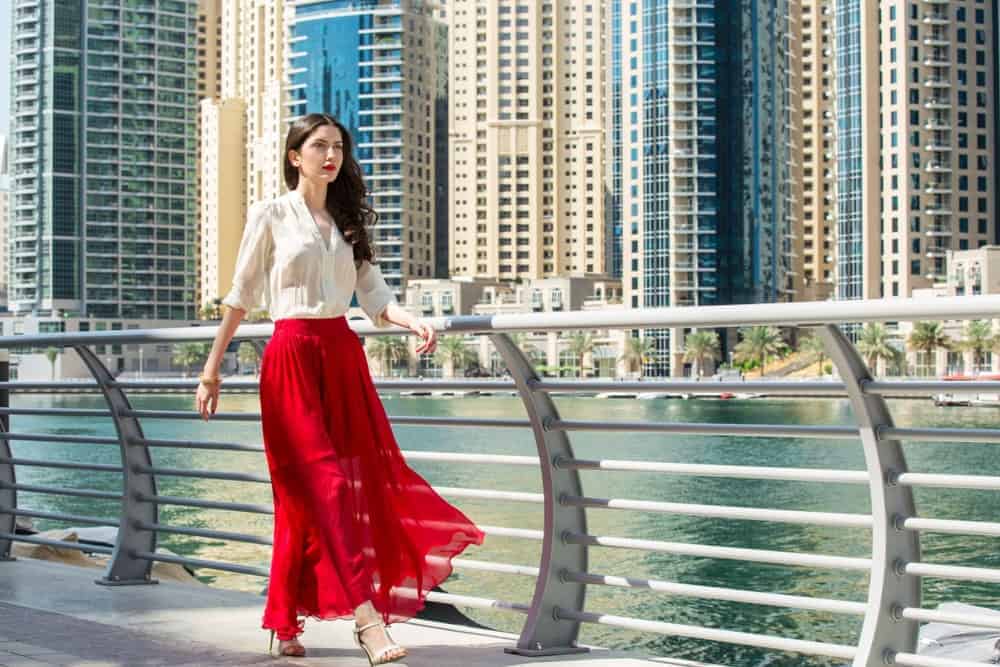
The maxi skirt, or maxiskirt, is any long skirt that goes past the middle of the calf but ends above the ankle. Maxi skirts are usually full skirts that may or may not have pleats, ruffles and asymmetrical hems. Some maxi skirts may have slits, tiers or other embellishments. Maxi dress styles have been very trendy in recent years.
Mermaid
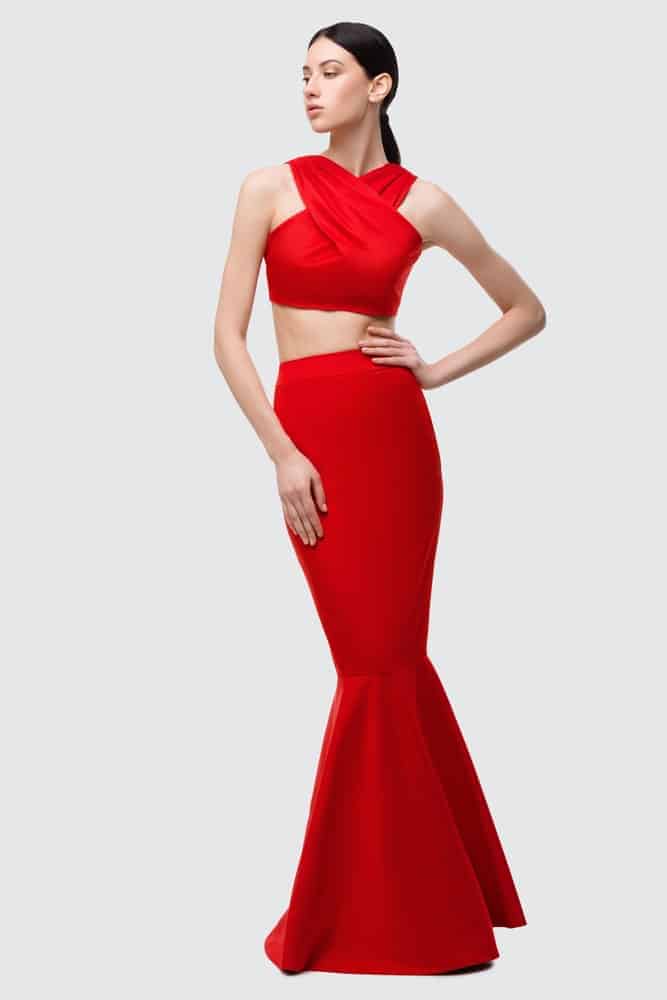
The first mermaid gown was created by designed Marcel Rochas in the 1930s. This is a distinct silhouette that gets noticed right away. The mermaid skirt is a full-length skirt that is close-fitting through the hips and thighs, then flares out past the knee. This skirt style is still seen frequently in fashion, appearing in formal wear and more casual skirts, too. Mermaid skirt styles are also called trumpet skirt styles.
Midi
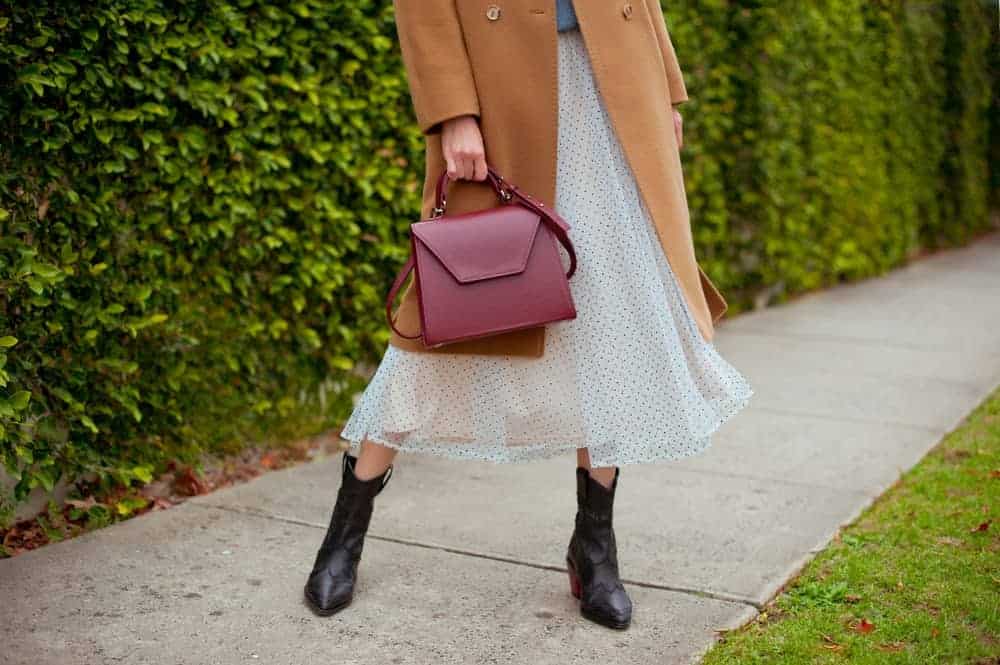
The midi skirt is a bit of a fashion anomaly. It looks like a style you would see in the 1950s, but it didn’t appear in fashion until the late 1960s. It disappeared pretty soon after that, vanishing from stores in the early 1970s as women moved on to new styles. But now the midi is back in popular fashion…and this time, it looks like it’s going to stick.
Style
In modern style, midi skirt length varies. But traditionally, this skirt falls to the mid-calf, about four inches below the knee. It flares outward from the waist, creating a full skirt. The midi skirt’s real claim to fame is not its look. It’s when the midi skirt appeared in fashion: right after the fashion juggernaut that was the miniskirt.
Mini
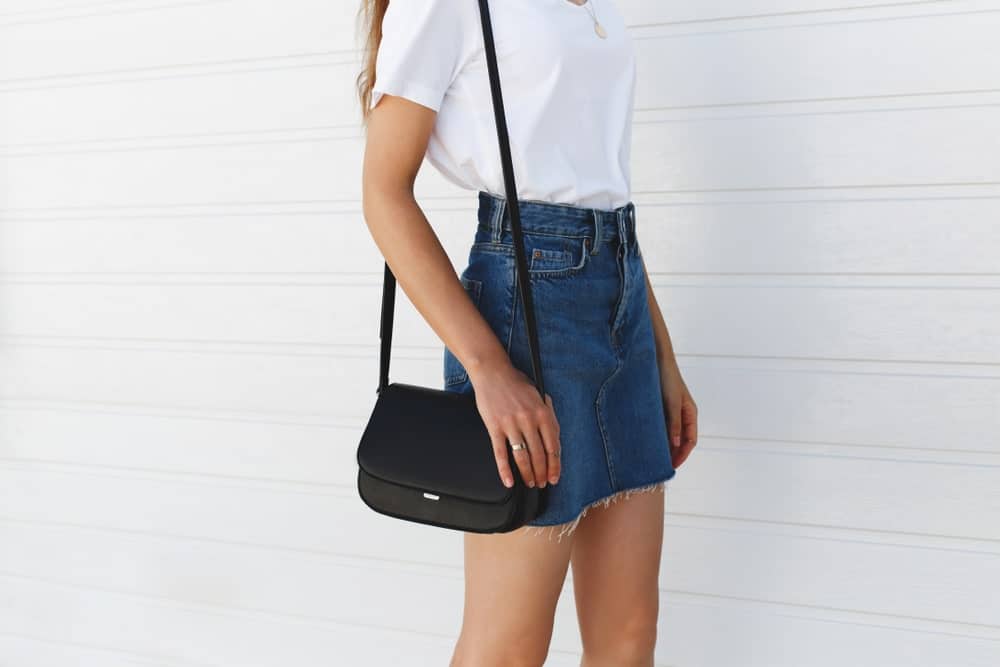
How many super short skirts have you worn? If you’ve made it to just about any age as a woman, you’ve worn a miniskirt or mini skirt at least once. It’s really no big deal at all for women of all ages to put on short skirts. But when these skirts first appeared on the fashion scene, they were totally shocking.
History
Mary Quant is famously the woman who created the miniskirt, which became THE look of the 1960s. According to Quant herself, the miniskirt must fall to about the mid-though and be no longer than this. It was a symbol of women’s liberation and freedom in fashion. It was scandalously short. It was destined to change fashion for ever. And…it was a design that was thousands of years old.
Actually, ancient Europeans living between 5400 to 4700 B.C.E. wore miniskirts. Frescoes from ancient Egypt show female acrobats wearing miniskirts as well. Since skirts were one of the first fashion items ever invented in human history, it makes sense that hemlines became short sometime before 1960.
Style
But Mary Quant at least came up with the modern version of this skirt type, right? Well…that all depends on how you look at it. Glamorous entertainer Josephine Baker was known to wear a miniskirt in the 1920s. In this same decade, the “flapper” fashion caught on and many women were experimenting with shorter skirts.
In the 1950s, very short skirts did appear in film in science fiction movies of the day. The movies envisioned a future where women wore their skirts short…very short. Thanks to Mary Quant, that future came true in 1964.
Variation
The micromini is an even more brief version of the miniskirt. This is a super short skirt type that has so little fabric, it can’t even be called a miniskirt…it’s a micro version. If you’re feeling bold, wear a micromini as part of a summer skirt outfit.
Paneled
A panel skirt, or paneled skirt, is made up of panels that can be widened or narrowed towards the bottom for an almost straight or twirly full skirt type. This is ideal for women who want to achieve the look of a slim waist.
A panel skirt is made with several panels of fabric that are sewn together to fashion any type of skirt. Just about any skirt can be a panel skirt. If you don’t have a lot of fabric to work with, a panel skirt may be a perfect solution.
Peasant
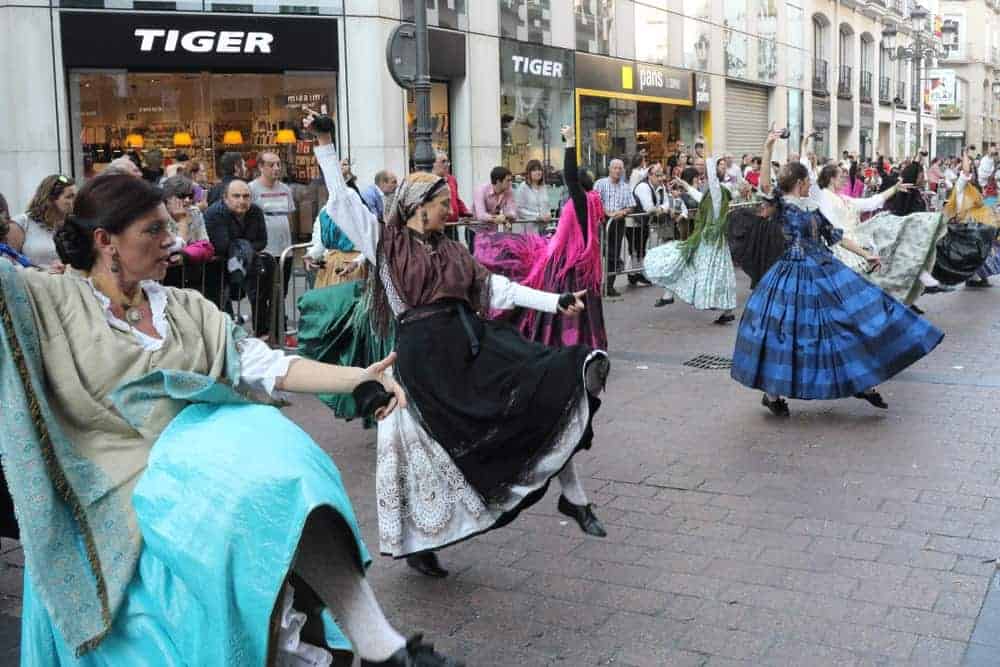
The peasant skirt is a long, full skirt with a lot of fabric. This skirt is at least ankle-length and may be floor-length. These are loose, flowing, casual skirts that can be embellished with tiers, ruffles or pleats.
Pegged
The pegged skirt, or peg-top skirt, was inspired by men’s pants. The peg-top look had caught on in menswear in the early 1900s. This style added extra fabric to the hips of the pants, often in the form of pleats, to create a more distinctive silhouette. From the enlarged hips, the trousers narrowed down to the ankle. They were kind of the original Hammer pants, but not nearly as baggy. The bigger hip style was more flattering on women than on men and soon, the peg-top style found its way into women’s wear.
Style
Pegged pants came first but soon, skirts were made with the pegged hipline. The look quickly caught on and became the hot look in the 1910s. This silhouette is still a part of the modern skirt arsenal and it’s still a good way to emphasize the female shape, slimming the waist and legs while emphasizing the hips.
Pencil

The pencil skirt is also called the fitted skirt, the straight skirt and the tube skirt because of its shape. It’s elegant, it’s glamorous, it’s sexy and it became a signature look of the 1950s and 1960s. Women everywhere wore the tight-fitting skirt, which skimmed the legs from hip to hem. The pencil skirt falls to many different lengths, from knee-length to mid-calf.
Style
The pencil skirt came to fame in the 1950s but it has never totally left the style scene since. Glamorous women of the ’50s like Marilyn Monroe and Grace Kelly wore them back then. Now, pencil skirts are still worn by royals like Meghan Markle and elegant women like Michelle Obama. They’re still sexy and glamorous and they’re still a huge fashion staple.
Peplum
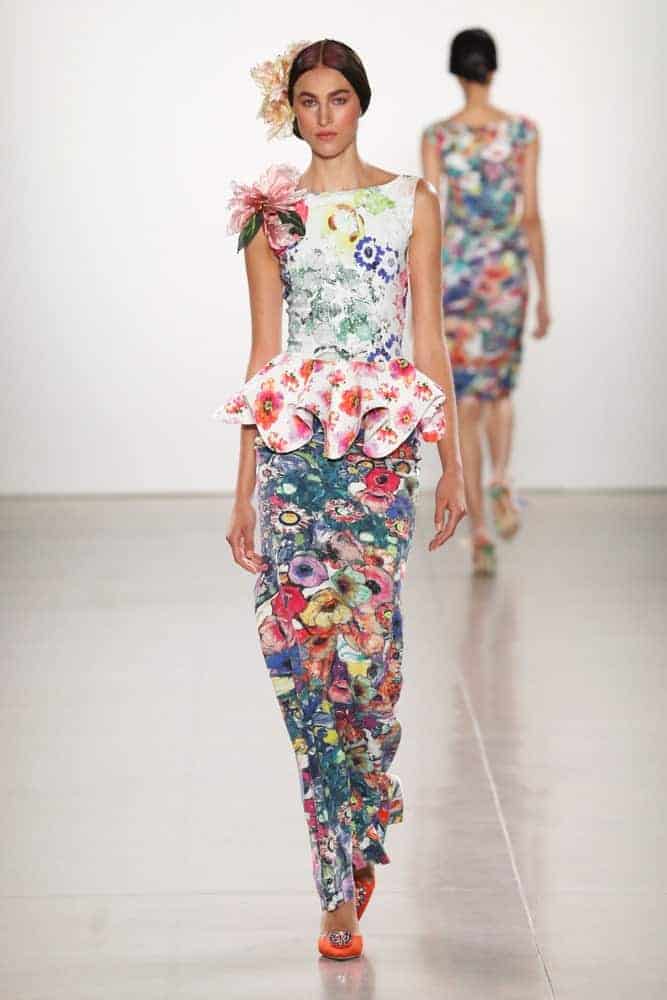
The peplum is definitely an interesting type of skirt. It is tapered and close-fitting around the waist and thighs, usually falling to about knee-length. But that’s not all. The peplum shirt wouldn’t be a peplum skirt without an extra ruffle of fabric around the waist. This extra piece of fabric is the same color as the rest of the skirt and it’s what gives this style its very distinct look.
History
The peplum was immortalized on the silver screen during the 1940s, when this look was worn by all the most fashionable dames. It was a perfect skirt to wear with a tailored jacket for a business look and became a beautiful look for evening wear at a fancy party or restaurant. But the peplum, like so many things, dates all the way to ancient Greece.
Around 500 B.C.E., the fashionable Greeks wore an outfit they called peplos. This is where the word peplum comes from. This outfit was a long tube of fabric that was draped and tied at the waist to create an extra fold of fabric for the top half of the body. This was then cinched a second time to add an extra flap around the waist, creating the peplum shape. Greek women often wore this look.
A more modern version of the peplum that didn’t require draping appeared for a brief moment during the Reinassance, about 1,000 years after the peplos was popular in Greece. Both men and women wore this skirt style, which re-appeared in fashion again 300 years later in the Victorian Era.
Style
The peplum didn’t take on its modern look until it blazed onto the style scene in the 1940s. The peplum is still seen today. It’s now a classic look that’s still sort of fun and flirty.
Pleated
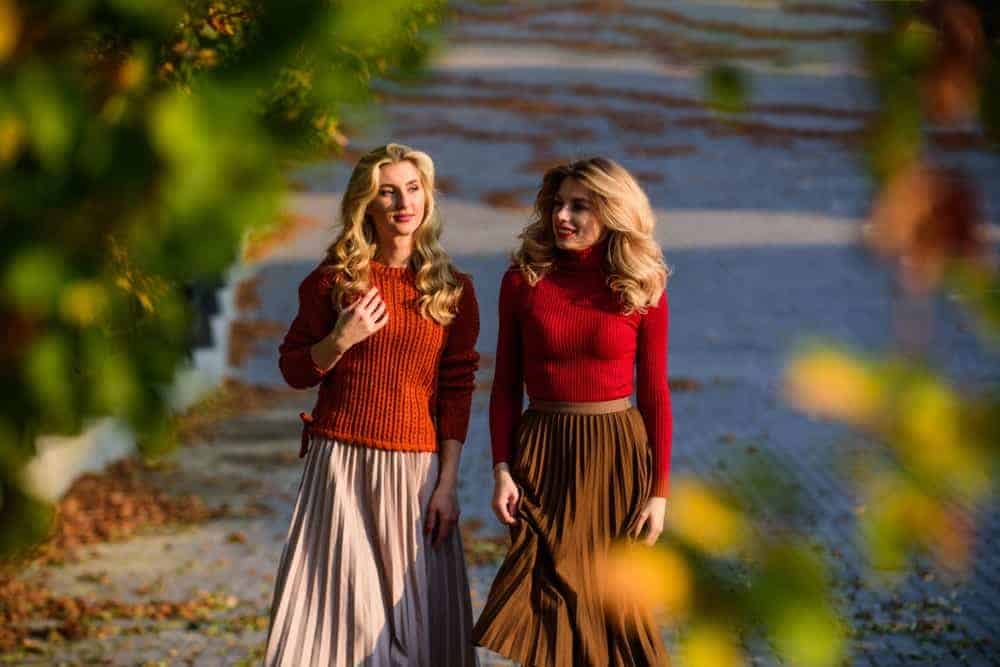
Pleated skirts are made with pleats. Any skirt can be a pleated skirt if it has pleats in it and may have only a few pleats, rather than being pleated all the way around. The pleats add extra volume and flare to skirts of any length. Pleats are made with the fabric is sharply folded. The pleats can be small or large, spaced widely apart or very close together.
Variation
One variation of the pleated skirt is the accordion skirt, which is heavily-pleated with many small pleats. The accordion skirt is usually a long skirt that has tightly pressed pleats into the skirt and they are layered on top of each other for an accordion-style effect. The bottom portion of the skirt is usually circular, which helps to aid in the mobility of the skirt. The accordion skirt can come in various colors and lengths.
Knife pleated skirts are the most common types of skirts worn with pleats. What makes this skirt stand out from all the other starts with pleats is that knife-pleated pleats are defined with sharp folds that go in and out and they overlap each other. Because of this, knife-pleated skirts can be worn in formal and casual settings, depending on the length and the type of material the skirt may be made from.
Poodle

The poodle skirt is really a variation of the circle skirt, but this style is so iconic it definitely deserves its own place on any list. The poodle skirt was the ubiquitous look of the 1950s thanks to Juli Lynn Charlot. She was an actress and designer who did not know how to sew. In 1947, she added some adorable poodle appliques to a felt circle skirt…and made fashion history.
Style
Circle skirts are easy to make, felt is pretty inexpensive and anyone can attach appliques to the fabric. This is how the poodle skirt trend was born and how it exploded. Soon, the poodle skirt was everywhere. Paired with ankle socks and saddle shoes, it’s really the most classic look of the 1950s.
The poodle skirt will always be a nostalgic piece of fashion’s past. And who knows? It may catch on again.
Prairie
Praire skirts are long skirts that are flared. Some prairie skirts are only slightly flared, while others are very full. The prairie skirt has one or more deep ruffles or tiers. They’re named after an 1800s style that was popular among early homesteaders. Back then, the skirts were made with cotton feed sacks or homespun cotton.
Style
Modern prairie skirts are not made with cotton feed sacks. However, they are often made with cotton and cotton blends, along with other soft fabrics. Prairie skirts have a beautiful natural drape and a flowy look to them that makes them a popular style for casual wear.
Variation
The modern boho skirt is a variation of the prairie skirt. Boho skirts are long and full, like prairie skirts. They’re made out of lightweight fabric, usually calico. This is a soft cotton fabric that’s printed with a pattern design. These skirts can help create many everyday outfit looks.
Rah-Rah
The rah-rah skirt, or ra-ra skirt, is inspired by the classic cheerleader skirt. The rah-rah skirt has two or more overlapping tiers of material or flounces. It’s a short skirt the typically ends above the knee. This is a great skirt to pair with an oversized sweater when you want a cute fall look.
Ruffle
A ruffle skirt, or ruffled skirt, can be many different types of skirts. Any skirt that has a ruffle is a ruffle skirt.
Sarong
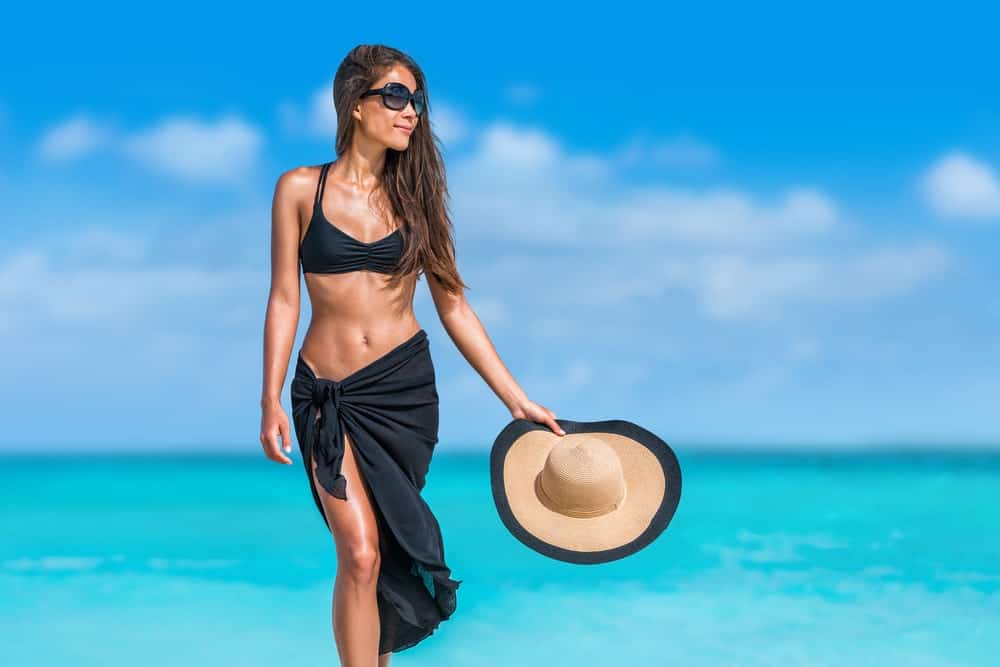
The sarong skirt is a traditional Asian garment that is wrapped around the body. Sarongs are typically made from lightweight fabrics. The sarong skirt is wrapped around the body in a slim tube, according to Fashion History.
Sarong skirts are skirts that are made to wrap around a person’s body as a skirt or scarf or as any other type of clothing article that an individual can think of creating. Sarongs are most known as a bathing suit essential. They can come in multiple colors, sizes, patterns and designs.
Scooter
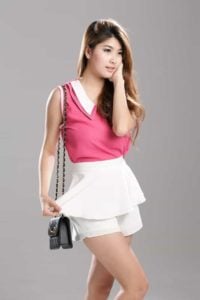
You probably know scooter skirts better as skorts. True scooter skirts are shorts that have a skirt layer covering them. The shorts are typically just a little bit shorter than the skirt, which is pretty short (at least several inches above the knee).
When they were first invented, skort styles were called trouser skirts. Skorts are not the same as divided skirt styles, which are pants that are made to look like a flared skirt.
Slip
Slip skirt styles are usually thin, lightweight skirts made with silky and satiny fabrics. These skirts look like slips and may be made in any skirt style, from mini skirts to maxi skirts. Slip skirt looks can be elegant and sexy.
Tea Length
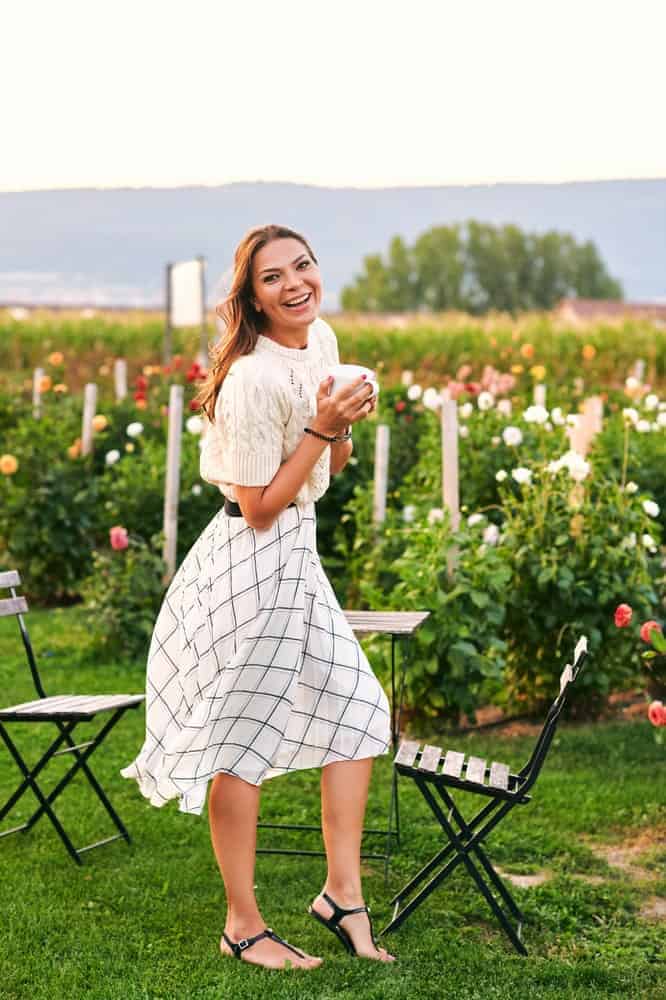
The tea-length skirt is about three to four inches past the knees, with the ankles fully exposed. This was a popular skirt style after the 1920s and tea-length skirts are still worn today.
Tiered

A tiered skirt is made with the fabric layered all the way down the skirt. This gives the skirt the appearance of being made up of different tiers. This design creates a ruffled, layered look with a full skirt. Depending on the fabric and style of the skirt, this type of skirt can be casual or formal.
Tulip

Tulip skirts are named for the line of the bottom hem. This is an asymmetrical hem that looks like the leaves of a tulip flower. The tulip skirt was created by Christian Dior in 1953 and quickly set the fashion world on fire. Tulip skirts have recently become popular again in fashion. These skirts are typically knee-length or longer.
Tulle

Tulle skirt styles can be made in any style or length. The important thing is that they are made with tulle. This is a lightweight, airy, mesh fabric that is most associated with tutus, also known as ballerina skirts.
Tutu

The tutu skirt is most associated with ballet and ballerinas. The tutu is a well-known look today and it has reached iconic fashion statute thanks to Sarah Jessica Parker’s famous walk down the street in the opening sequence of “Sex & the City.” This skirt has a long history in fashion and definitely won’t be fading from the spotlight anytime soon.
History
According to Pointe magazine, ballerina Marie Taglioni was the first to wear a tutu skirt in a performance. Dancing the title role in “La Sylphide,” she danced onto the stage in 1832 wearing the first tutu, a dress with a bell-shaped skirt. The look became the model for every other ballerina.
These first tutus were made with cotton muslin and gauze, lightweight fabrics that created the airy, ethereal look of the tutu. In the early 1900s, advances in sewing technology made it much easier to make tulle, which had previously been made entirely by hand. Muslin, gauze and tulle were stiffened with starch and used to make the layers of the tutu stiffer to create the appearance that the ballerina was floating.
Changes in lighting technology changed the look of the tutu as well. Early tutus were lit by candlelight, so they were woven with metallic thread and sequins that could catch and reflect the flickering lights. But in the early 1900s, gaslights were used. This lighting was much brighter. However, it also made things more dangerous. The lightweight fabrics of tutus were highly flammable. Many ballerinas died as a result of their dresses catching on fire due to gaslights.
Style
As the decades rolled by, tutus became shorter. They started out falling nearly to the ankles. By the end of the 1800s, they shortened to just above the knee. Shorter tutus became popular in the 1930s, now exposing most of the leg. Tutus became even shorter in the 1960s, taking on a look more like modern tutus.
However, tutus are still evolving and designers are still playing with this now-classic style. The modern tutu is now more about the shape than the material. It is a short, stiff, flared skirt that exposes almost all of the leg and it is still favored by ballerinas around the world.
Underskirt

Once known as a petticoat, the underskirt is a separate skirt you wear under the dress or the skirt you plan on displaying for the world to see. This can be used to add extra warmth to what you’re wearing or prevent someone from seeing through thin fabric.
They can also be used to add structure to a skirt. Petticoats were once worn in layers, with many women wearing several at once. They were seen again in the 1950s to add volume to the flared skirts that were popular at the time.
Wrap

Wrap skirts are wrapped around the body and usually tied into place with a drawstring or with the material of the skirt itself, though some designs may have buttons or snaps. Wrap skirts can be any length. Sarongs are a type of wrap skirt.
History
Wrap skirts are still popular in fashion but they are one of the oldest types of skirts. Ancient Egyptians wore a type of wrap skirt.
Yoke
Many types of skirts can be yoke skirts or yoked skirts. This adds a little extra structure and interest to a skirt. The yoke is like an extended waistband that goes from the waist to the hips. A yoke design can be used with many different types of skirts.
Men’s Skirts
Men wear skirts, too. If you take the history of fashion into account, men have worn skirts far more than they have worn pants. There are some men’s skirts that are still worn today, mainly for ceremonial purposes.

The fustanella is a knee-length, pleated skirt that is worn in Greece and Albania. The fustanella, also called fustanelle, is made with white fabric.
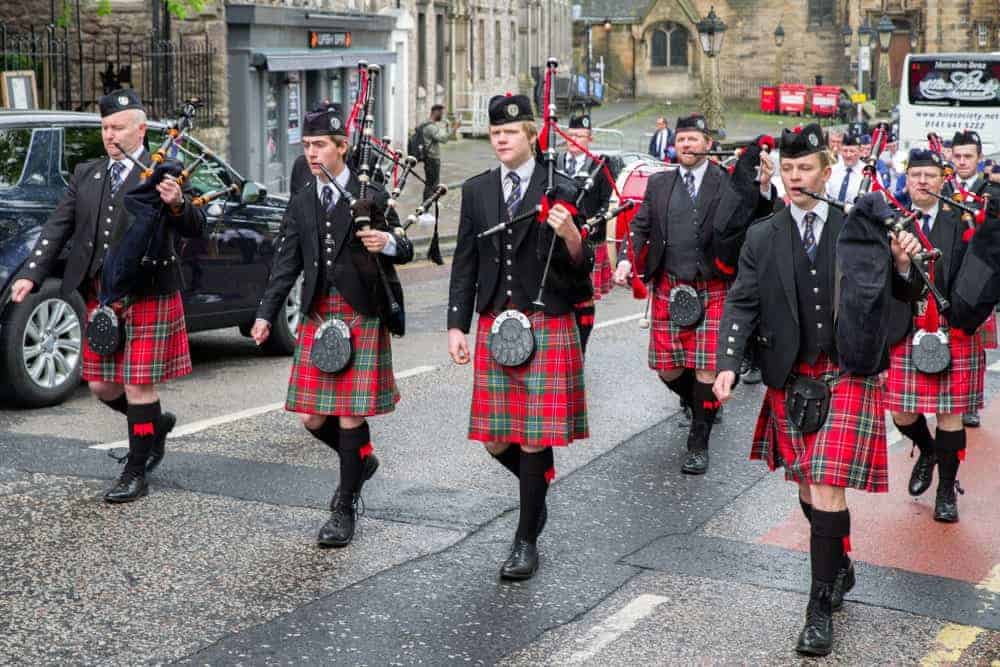
Modern kilts evolved from the tartan, a woolen wrap that was commonly worn for warmth in the chilly Scottish weather. It became fashionable to take the large warps and belt them around the waist, creating folds. This was known as belted plaid. The earliest use of kilts was at the end of the 1500s. This look inspired the modern Scottish kilt, which is still worn today for ceremonial and cultural events.
Skirts for men have started to come back in fashion, with some designers presenting their take on skirts for men in recent years. Modern men’s skirts are typically styled in longer lengths that fall below the knee and often have pleats.
Materials
Skirts are made out of many different materials that play a big role in how any skirt type fits and feels. Choose skirts not just on style but also on fabric.
Cotton
Cotton is by far the most popular and one of the most comfortable types of fabrics, in part because of its breathable qualities. It is a soft and flexible fabric, which means skirts made of cotton are always extremely comfortable and accommodating. Cotton also comes in various thicknesses and can be blended with other fabrics. This is a natural, hypoallergenic material.
Cotton Lawn or Voile
Also called lawn cloth, this type of fabric is made mostly of cotton and is similar to batiste but with a little more structure. It contains very fine threads and resists wrinkles, keeps the skirt’s shape and has an almost transparent quality. In addition to skirts, this material can also be used to make drapes and clothing for warmer weather.
Denim
Denim is a sturdy type of cotton with a twill weave pattern and diagonal ribbing. It is a warp-faced type of fabric that is most commonly used to make jeans and skirts. It is a very comfortable and popular material.
Denim skirts are very versatile and can fit into casual, formal or elegant categories. Denim skirts can also come in a variety of designs such as short, long, light, dark, straight or pleated, and so on. These types of skirts can also be used in the workplace setting if they are cut in a certain pattern. They can be accessorized with all kinds of crafts such as rhinestones, buttons, tye-dyed glued or paints, and other sorts of crafts.
There are many denim skirt styles out there, from full-length designs to denim mini skirt looks. The possibilities with denim are endless.
Jersey Knit
Jersey knit is a popular material for many types of clothing and today it is made of a blend of synthetic fibers, wool and cotton, although it was originally made of pure wool. It is known for very small, close-knit stitches and its characteristics include warmth, durability, looseness and softness. In addition to skirts, items like T-shirts can also be made of this material.
Leather
Leather has been used to make clothing since the earliest days of clothing. This material is highly durable. Leather is wear-resistant and maintains its beauty over time, often developing a patina with use that gives it even more character.
Leather is not always easy to clean, however, and can be subject to staining due to oil, water and grime. A leather skirt can be hard to maintain but it’s also a look that many find worth the extra work.
Alternatives to leather are made to resemble real leather in appearance and characteristics. Faux leather is often made from plastic.
Linen Blend
Like cotton, linen is durable, strong and soft, but linen blends are made with other materials as well and have advantages that include an ability to become stronger when wet, resistance to bacteria and high absorption capabilities. Linen blend skirts are extra comfortable and low-maintenance.
Poly-Cotton
This is a mixture of cotton and polyester, and the reason it is so popular for skirts is that it is easy to care for and slow to wear out or stain. The polyester makes the skirt strong and resistant to wrinkles, while the cotton makes it soft and comfortable.
Since cotton is generally more costly than polyester, this blend is a great way to enjoy a mostly cotton fabric at a much lower price.
Poplin
Poplin fabric is very strong and is made of a plain weave of almost any type of fiber or blend. It is usually made with a corded surface and can be polyester, silk, wool, rayon or a combination of these materials.
Skirts that are made of poplin tend to be slow to wrinkle and easy to iron.
Rayon
Rayon can imitate other fabrics, including cotton, wool, silk and linen. It is made from cellulose that comes from wood pulp. Although rayon is made with natural materials, it is not considered a natural fabric because the process to turn it into a wearable fabric is quite extensive. It is still, however, a very popular material for both skirts and other apparel.
Seersucker
Seersucker is usually made out of either synthetic material or a natural material, such as cotton. It has a surface made of both flat and puckered sections, giving it a truly unique and interesting look and feel. Seersucker often is striped or has various patterns and designs on it. The fabric is distinct because it has a wrinkled appearance.
Stretch Cotton
Stretch cotton is not exactly stretchy like elastic but instead, it has a small amount of “give,” which is just enough to make it super comfortable and accommodating. It has either a two-way or four-way stretch when being made, and it moves with you all day long, which makes it perfect when you’re looking for something that is both comfortable and long-lasting.
Twill
Twill fabric is a woven fabric that is usually made out of materials such as cotton, silk or polyester, and it is characterized by parallel, diagonal ridges. Some of the many characteristics of a twill skirt include resistance to staining, its durability and its attractive look.
Twill also resists wrinkles and creases, and it gives skirts and other articles of clothing a unique and sturdy look. Twill is a very popular type of material to make a skirt from, not to mention items like hats and blazers.
FAQs
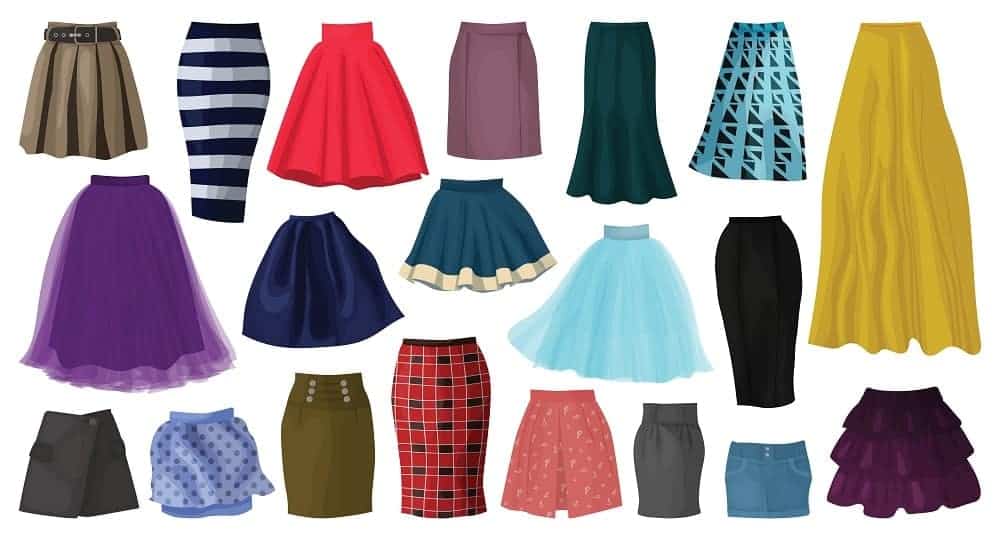
How many types of skirts are there?
There are many different types of skirts out there. Once you factor in historical skirts and ceremonial skirts from around the world, the numbers get even bigger. Designers are creating new looks all the time so the variations of skirts change practically every year.
Which types of skirts are in fashion right now?
Midi skirts are popular in fashion right now. They’ve been appearing regularly on runways. Material-wise, denim has been showing up everywhere. All the celebs have been sporting it, so you know it’s trendy.
According to Marie Claire, longer wrap styles are another hot look. Ruffled skirts are also definitely an “in” look.
Which types of skirts are easy to sew?
The circle skirt is a very easy design to DIY. Gypsy skirt styles are another type of skirt that’s easy to make at home, as are wrap skirts. If you have a sewing machine, there are many types of skirts you can make in a relatively short amount of time.
Which types of skirts work for your body type?
There are many different body types out there and not everyone can wear any style of skirt they want. So which types of skirts are going to look good on you?
If you have an apple shape, also called a round shape, high-waisted skirts will suit your shape. Flounces and ruffles also work. Wear shorter hemlines when you can to emphasize your legs.
Do you have more of a straight shape? You can successfully wear miniskirts and maybe even microminis if you’re feeling brave.
Are you curvy? Hourglass shapes look really great in pencil skirts, which help show off those curves.
Pear-shaped bodies are well-displayed in A-line skirts.
Which skirts look good in plus sizes?
Big is beautiful! If you’ve got curves, there’s no reason you can’t show them off in any type of skirt you like, from a hip-hugging pencil skirt to a flowing maxi to any other style that may catch your eye.
The rule of dressing, whether you’re plus-sized or quite skinny, is to wear clothes that fit you. Don’t try to hide your curves if you’re a plus-sized woman. Celebrate them!
How many skirts should a woman own?
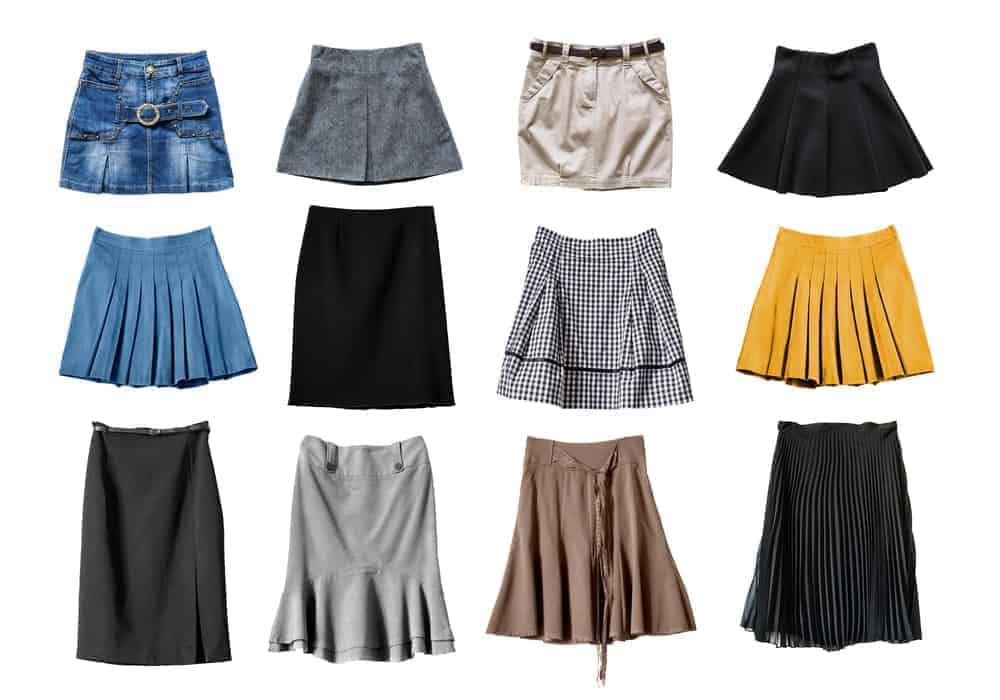
If you like wearing skirts and wear them for casual wear, office wear, and evening wear, you’ll have more skirts than a person who doesn’t really enjoy wearing them and typically chooses slacks more often.
To have a basic skirt wardrobe where you can wear a skirt for any event that may crop up, get a midi skirt for casual looks, a peplum skirt for cocktail parties and evening events, and all-occasion maxi skirt, and an A-line skirt you can use for professional and stylish looks.
Can skirts be taken in or let out?
There are several alterations that can be made to a skirt. This includes hemming the skirt, shortening it, and adjusting the waist. Just about any skirt can be taken in to make it smaller but not every skirt can be let out to make it bigger.
Why do field hockey uniforms have skirts?
Field hockey is an ancient sport. Paintings and sculptures dating to 4,000 years ago show people playing games that look a lot like field hockey, suggesting that this sport has been around for a long, long time. However, field hockey has only been played in the U.S. as a sanctioned sport for about a century.
Women’s field hockey teams often wear skirts as part of their official uniforms. As for why that is, there is no one answer to this question. It is not in the official rules that players must wear skirts. Many chalks it up to “tradition” that women wear skirts as part of their official uniforms, but the first women’s field hockey team at a U.S. college did not wear skirts in their official uniforms.
The question remains as to why women wear skirts while playing field hockey and many have spoken out against this trend in sports. While there is no official reason for wearing this uniform, it has become the norm for field hockey.
Which types of skirts can you wear with sneakers?
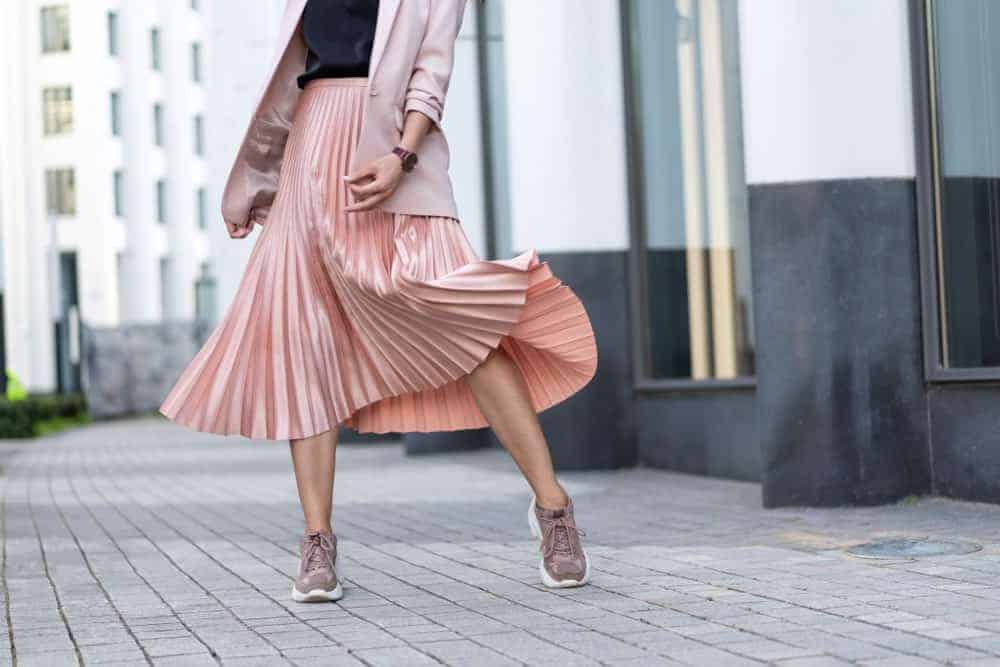
More people are pairing skirts with sneakers and this look has become quite popular. Sleek canvas shoes are a great partner for many types of skirts, including minis. Try pairing athletic shoes with longer dresses, like maxi styles.
Sneakers look especially great with skirts when worn with invisible socks. Wear bootie-style socks or very low-cut socks so they don’t show with the sneakers to get the look.
Can you wear skirts with sweaters?
Wearing a sweater with a skirt is a great look for fall or early spring. You can also pair a sweater with a skirt in winter if you have some warm tights to keep your legs warm.
A pleated plaid skirt looks great with a sweater as a cute fall outfit. Any skirt can look good with a sweater if you pair the right items together, from a long maxi length to a short miniskirt. Finish the look with a pair of heels or boots and you’ll look very stylish.
Which types of shoes can you wear with skirts?
If you’re creative and you like the way you look, you should wear any shoe /skirt combination you want to wear. However, there are some standard combinations that you can try if you’re looking for a quick style hack.
Pair a pencil skirt with low heels for a great professional look. For something a bit more high-fashion, try a pair of tall boots or some strappy sandals. A tulip skirt or wrap skirt looks great with peekaboo heels if you need a business casual look. Turn it into cocktail attire with some strappy sandals. If you’re going for a more casual look, try some simple canvas sneaks or ankle-high boots.
A flared skirt looks great with heels in any style, from tall boots to ankle boots to classic pumps. The A-line skirt works with a variety of shoe styles. Wear flats, heels, sneakers or ankle-high boots to cap off this skirt. Boots in any style are perfect for the mini skirt, which also looks great with high heels.
Create a cute casual look with a mini skirt and sneakers, flats or low heels. A maxi skirt looks great with high heels or platforms, according to Top of Style.
What types of skirts do royals wear?
Members of the royal family actually must follow strict fashion protocols. There are many rules that royals must follow, including their skirt lengths. You’ll notice that most royal women wear their skirts around knee-length. According to Cosmopolitan, skirts for royal family members should never be more than four inches above the knee, which rules out miniskirts and several other skirt styles. Knee-length skirt looks are worn by many female members of the family.
Fashion gossip says that the Queen uses a very clever hack to keep her skirts from blowing up on windy days: she has someone sew little weights into the hems. Known as penny weights among royal fashionistas, they hold her dress down so even a stiff English breeze can’t blow the fabric up!
Is a kilt a skirt?
By technical fashion definitions, a kilt is most certainly a type of skirt…though some people will passionately argue that it is not. Since a kilt is a piece of fabric wrapped around the waist that covers the lower body, it does fit the definition of being a skirt. It’s not a classic women’s skirt, however. The kilt has become a much more popular style for men.
References:
Glamour – An Important Dressing Lesson: Let’s Talk Hemlines
LoveYourTailor – What Can a Tailor do for Women
Sew Guide – 20 Different types of SKIRTS you need to know about!!
The Shapes of Fabric – Discover how to draft flared and pleated skirts
WhoWhatWear – The 2-Piece Outfit Combo Fashion Girls Can’t Stop Wearing





